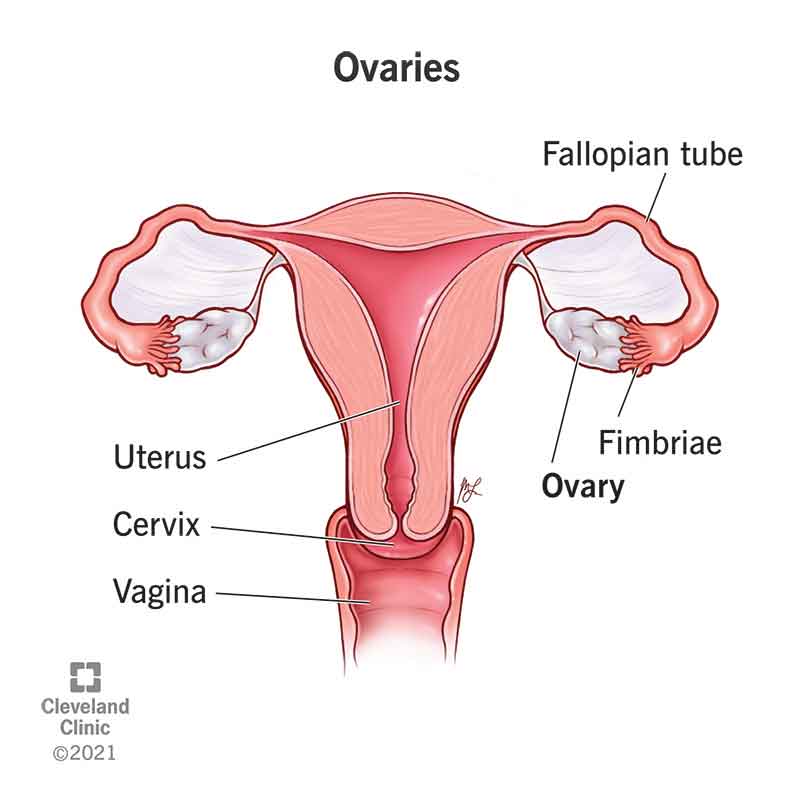Your ovaries produce eggs and hormones for menstruation and pregnancy. You have one ovary on each side of your uterus. Certain conditions or diseases of the ovaries can cause painful symptoms and require medical treatment.
Advertisement
Cleveland Clinic is a non-profit academic medical center. Advertising on our site helps support our mission. We do not endorse non-Cleveland Clinic products or services. Policy

Ovaries are small, oval-shaped glands located on either side of your uterus. They produce and store eggs and make hormones that control your menstrual cycle and pregnancy. During ovulation, one of your ovaries releases an egg. If a sperm fertilizes this egg, you can become pregnant. Sometimes, your ovaries can release more than one egg and cause a multiple pregnancy. Your ovaries release an egg each menstrual cycle until you reach menopause.
Advertisement
Cleveland Clinic is a non-profit academic medical center. Advertising on our site helps support our mission. We do not endorse non-Cleveland Clinic products or services. Policy
Your ovaries are important for your menstrual cycle and getting pregnant. They make the hormones estrogen and progesterone. Each cycle, one of your ovaries releases an egg (ovulation).
Inside your ovaries are thousands of tiny sacs called follicles. These follicles each hold an immature egg. Between days six and 14 of your menstrual cycle, a hormone called FSH (follicle-stimulating hormone) helps some of these follicles grow. Then, around day 14, a sudden surge in LH (luteinizing hormone) causes one follicle to release its egg.
You have two ovaries. One on the right side and one on the left side of your uterus. Your uterus is in your lower abdomen. Several muscles and ligaments hold your ovaries in place. The ovarian ligament connects your ovaries to your uterus, but your uterus and ovaries don’t touch.
Your ovaries are oval-shaped and firm with a slight texture. They can be any shade between light gray and white.
Your age determines how big your ovaries are. Your ovaries can be as large as a kiwi (around 6 centimeters) before menopause. Your ovaries get smaller as you get older and can be as small as 2 centimeters (size of a kidney bean) after menopause. The average size of an ovary is around 4 centimeters. Studies show that the size of your ovaries declines every decade of life once you turn 30.
Advertisement
Your ovary has three layers. The outer layer is a protective coating, like a capsule found on medicine. The middle layer is made up of connective tissue and contains follicles that hold eggs. The innermost layer contains blood and lymphatic vessels.
If you have a problem with your ovaries, you could experience:
Pain in your ovaries can feel different for everyone. Some describe it as sharp and sudden, while others experience a dull ache that comes and goes. It can also feel like pressure or a twinge. You may feel something in your ovaries around ovulation. But you may also feel pain during sex or when you pee.
Several conditions can affect your ovaries. Some of the most common ones are:
Your healthcare provider uses the following tests to help diagnose ovarian conditions:
It depends on what’s wrong. Some of the most common treatments are:
You can’t get pregnant on your own without ovaries, but pregnancy might still be possible. If you still have a uterus, IVF (in vitro fertilization) could be an option.
The most common reason for removing ovaries is to treat ovarian cancer. Some women choose to have them removed as a preventive step if they’re at high risk for ovarian or breast cancer. Removing your ovaries is also a treatment for certain conditions when more conservative treatments don’t work.
Ovaries play a big role in reproductive health. They make important hormones, help control your menstrual cycle and release an egg each month. Things like pelvic pain, unusual vaginal bleeding or changes in your period could all point to a problem with your ovaries. If you notice anything like that, it’s a good idea to call a healthcare provider. They can make sure everything’s working as it should.
Advertisement
From routine pelvic exams to high-risk pregnancies, Cleveland Clinic’s Ob/Gyns are here for you at any point in life.

Last reviewed on 07/11/2025.
Learn more about the Health Library and our editorial process.